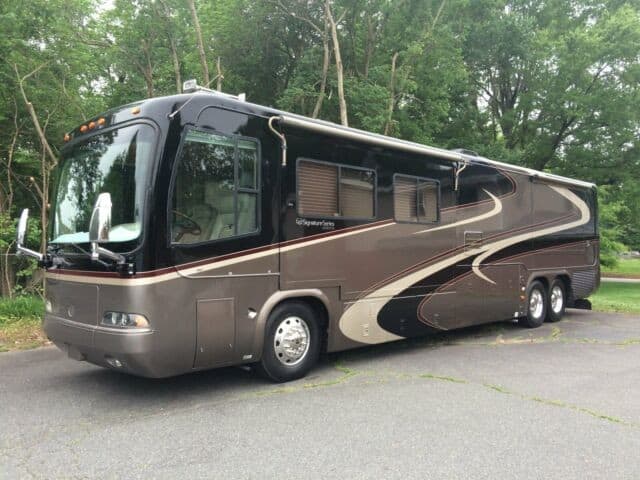Contents
Things to Remember When Driving a Class A Motorhome
- Brakes
- Following Distance
- The Wind
- Turning
- Maintenance
A Class A motorhome is a wonderful vehicle. It has all the comforts of home, like a shower and a decorated living room, on the road!
They usually all have onboard generators on them. This is nice because you can run the micro-wave to fix some soup for lunch as you travel. Then you might also want a cup of coffee or tea so you can run your coffee pot.
You can skip the high costs of a hotel room. Get closer to nature when you stay at a campsite. Make your road trips more enjoyable and comfortable. They are a great way to go for some great adventures!
But before you can embark on those great adventures, you’ll need to drive there. So here are some things you need to remember and check.
Brakes
With a car, you can hit the brakes suddenly and expect the vehicle to stop. The more pressure you apply, the more the brakes are engaged.
This doesn’t work very well with Class A motorhomes. That’s because they use a different braking style. Normal cars use ABS while most Class A motorhomes use air brakes.
The advantage of air brakes is they are more effective, but they do take some getting used to.
The pressure you apply doesn’t affect anything with air brakes. Instead, what matters is the length of time you press the pedal.
It takes around one or two seconds pressing the pedal before the brakes get applied. The longer you hold down the pedal, the more stopping power it generates.
This different braking style means you’ll need to be extra cautious while driving. You won’t be able to brake suddenly like you can in a car.
You’ll need to anticipate stops as much as possible. Never put yourself in a position where you may need to stop quickly. Be cautious when taking sharp corners.
Scan the road often for pedestrians and animals that may dart into the road suddenly. Use a co-pilot as an extra set of eyes.
Following Distance
Because of the slower brakes, you will need to leave a greater following distance. Aim for 4 to 5 seconds between you and the vehicle ahead of you. If you need to break, this gives you more time and distance to do so safely.
Of course, leaving this much space can result in an annoying driving situation. Other drivers may take advantage of and dart in front of you.
This happens to all RV drivers (especially when people are frazzled during rush hour traffic). It’s annoying, but try your best to shrug it off.
When someone cuts in front of you, be sure to slow down to get that follow distance back.
Adapting To The Wind
It’s no secret that Class A motorhomes are massive. They tower over others that are on the road, often reaching heights of 13 feet and lengths of 30 feet and more.
This is a huge jump in size when it is compared to your car. This gives a lot of extra space for catching the wind, either from nature or gusts from passing cars and trucks. When you increase your speeds, you’ll notice this even more.
Try to resist the urge to overcorrect as much as you can because it can be dangerous. Try to do only what you need to stay stable.
Before you start up your motorhome and head out, check the weather conditions if you can. If there are any wind advisories, you may want to wait them out. You can always hit the road in an hour or two if and when the wind dies down.
Turning
Class A motorhomes turn different than cars. They have a higher center of gravity, making them vulnerable to tipping if you take a corner too fast. You’ll need to adapt your turns accordingly.
Before you reach the turn, reduce your speed five to ten miles under the speed limit. Let off your brakes as you enter the turn. As you go through the turn, you can start accelerating slightly to shift the center of gravity towards the center of your RV. With a little caution, you can handle turns safely.
Vehicle Maintenace Is Very Important
Top 10 Tips to Successfully Maintain Your RV
- Inspect your roof seals and the seams of your RV. …
- You should tighten your RV’s wheel lug nuts to make sure they’re tight.
- Always remember to check the tire pressure. …
- You should always check your RV’s batteries. …
- Keep your wastewater system in good condition. …
- Keep your RV’s brakes maintained. …
- Clean and treat your RV’s slide outs and seals. …
- Change your RV’s oil. …
- Keep your RV’s awning maintained.
Here is a good thing to have
